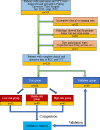T.H.R.O.B.V.S. Score - A Comprehensive Model to Predict the Surgical Complexity of Renal Cell Carcinoma With Tumor Thrombus
- PMID: 35814463
- PMCID: PMC9261335
- DOI: 10.3389/fonc.2022.900550
T.H.R.O.B.V.S. Score - A Comprehensive Model to Predict the Surgical Complexity of Renal Cell Carcinoma With Tumor Thrombus
Abstract
Background: To propose a quantitative model for predicting the surgical complexity of patients with renal cell carcinoma (RCC) and venous tumor thrombus (VTT).
Method: The clinical data of 226 cases of RCC with VTT in Peking University Third Hospital from January 2014 to August 2020 were retrospectively analyzed. Seven indicators were selected to establish the T.H.R.O.B.V.S. system, including alkaline phosphatase, tumor thrombus height, maximum tumor diameter, obesity, bland thrombus, vascular wall invasion, and side. Each indicator was assigned with 0, (1), and 2 points, and the total scores of 0~2, 3~5, and ≥6 were set as the low-, middle-, and high-risk groups, respectively. The surgical complexity was compared and validated among groups.
Results: As the risk increased, the proportion of open surgery significantly increased (P<0.001). The operation time (P<0.001), intraoperative blood loss (P<0.001), blood or plasma transfusion (P<0.001), and hospitalization (P<0.001) increased significantly. The postoperative complications (P<0.001), including notable complications (≥Clavein-Dindo II, P<0.001), were significantly different, and similar trends were shown in the validation group.
Conclusion: The T.H.R.O.B.V.S. scoring system is a quantifiable and satisfactory model to predict the surgical complexity and perioperative management of RCC with VTT.
Keywords: nephrectomy; prediction model; renal cell carcinoma; surgical complexity; thrombectomy.
Copyright © 2022 Wang, Liu, Hong, Qin, Zhao, Zhang, Liu, Ge and Ma.
Conflict of interest statement
The authors declare that the research was conducted in the absence of any commercial or financial relationships that could be construed as a potential conflict of interest.
Figures



Similar articles
-
Renal cell carcinoma with tumor thrombus growing against the direction of venous return: an indicator of complicated surgery and poor prognosis.BMC Surg. 2021 Dec 28;21(1):443. doi: 10.1186/s12893-021-01448-0. BMC Surg. 2021. PMID: 34963464 Free PMC article.
-
Imaging predictors for assessment of inferior vena cava wall invasion in patients with renal cell carcinoma and inferior vena cava tumor thrombus: a retrospective study.Chin Med J (Engl). 2020 Sep 5;133(17):2078-2083. doi: 10.1097/CM9.0000000000000828. Chin Med J (Engl). 2020. PMID: 32898352 Free PMC article.
-
Surgical complexity and prognostic outcome of small volume renal cell carcinoma with high-level venous tumor thrombus and large volume renal cell carcinoma with low-level thrombus.Chin Med J (Engl). 2019 Aug 5;132(15):1780-1787. doi: 10.1097/CM9.0000000000000352. Chin Med J (Engl). 2019. PMID: 31306232 Free PMC article.
-
Clinical management of renal cell carcinoma with venous tumor thrombus.World J Urol. 2014 Jun;32(3):581-9. doi: 10.1007/s00345-014-1276-7. Epub 2014 Apr 22. World J Urol. 2014. PMID: 24752606 Review.
-
Important surgical considerations in the management of renal cell carcinoma (RCC) with inferior vena cava (IVC) tumour thrombus.BJU Int. 2012 Oct;110(7):926-39. doi: 10.1111/j.1464-410X.2012.11174.x. Epub 2012 Apr 30. BJU Int. 2012. PMID: 22540179 Review.
Cited by
-
Construction of the prognostic model in non-metastatic renal cancer patients with venous tumor thrombus.Transl Androl Urol. 2023 Nov 30;12(11):1645-1657. doi: 10.21037/tau-23-341. Epub 2023 Nov 14. Transl Androl Urol. 2023. PMID: 38106682 Free PMC article.
References
LinkOut - more resources
Full Text Sources
Research Materials

